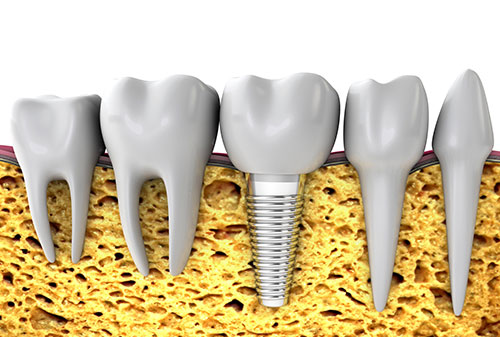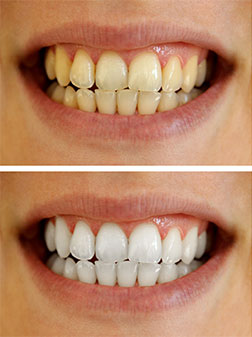Chips, Gaps, and Defects:

A chipped front tooth or gaps between teeth can be very distracting to an otherwise great smile. Dark spots, staining or uneven sized teeth may diminish confidence.
Good news, these are all potentially solved in one or two visits. In most cases, white filling materials (composite resin bonding) that are matched to the shade of your teeth can fill these chips, gaps and defects, all in a single visit. Sometimes referred to as “instant orthodontics”, white fillings fill voids, reshape teeth, and even bring teeth into alignment for an instant smile improvement. For larger chips, gaps, or defects, perhaps veneers or crowns may be indicated.
Veneers are thin porcelain shells that are bonded to the fronts of teeth, while caps or crowns cover over the entire tooth. Veneers are recommended when most of the tooth is not restored, while crowns are recommended when a lot of the natural tooth structure has been lost.
Veneers and crowns are more expensive than white fillings and may take a couple more appointments (although, with our innovative Nevo™ system, many crowns at the back of the mouth are done in one appointment). They are stronger, more color stable, and provide better esthetics. And for the difficult staining cases resistant to simple whitening, veneers and crowns are little miracles!
Missing Teeth:

A gap caused by a missing tooth or teeth can be readily solved. With only one or two teeth missing, the options to fill the space are implants, bridges, or partial dentures. For patients missing all their teeth, complete dentures or implant supported bridges and/or dentures are recommended.
Implants are titanium screws embedded into the jaw bone to act as roots of teeth. The screw is then allowed to fuse (anywhere from two to six months). Once integrated, it is built up with a crown to resemble a natural tooth. Implants are ideal if the other teeth surrounding the space are non-restored, “virgin” teeth. Implants can be a single unit or multiple units as when supporting fixed bridges or removable dentures.
Fixed Bridges are caps that bonds two or more natural teeth on either side of the lost tooth by crowning or capping each tooth, joined together by a crown in the middle. It is fixed, meaning you can not remove it, thus feeling like your own natural teeth. Economically about the cost of three or more crowns, a bridge is recommended if the adjacent teeth are also structurally weak and would also benefit from full crowning.
Partial dentures can be made of all acrylic with metal wires or of cast metal with acrylic teeth. They are held in the mouth by a combination of suctioning to the palate and ridges of bone where the tooth is lost, holding onto to remaining teeth, and by the muscles in the cheeks. These are REMOVABLE – meaning they are made to be taken out of the mouth at least once a day and especially throughout the night.
Complete dentures are acrylic dentures supported by the soft tissues of your mouth – mainly the palate, the gummy ridges where teeth used to be, and the muscles in the mouth. Good news is that many completely edentulous patients are getting as few as two implants to support a better fitting denture, or as few as four implants for a full arch fixed bridge.
Teeth Whitening

Next to a nice pair of eyes, the first thing people notice about you is your smile. In particular, they notice how white your teeth are. Nowadays, whiter smiles are more often “created” than “genetic”.
What causes teeth to discolor?
Extrinsic Stains:
These are factors that can stain the outside layer of teeth. Poor oral hygiene, smoking, eating certain foods (eg. foods prepared with dark dyes such as soy sauce), drinking certain beverages (eg. coffee, tea, colas), and certain medications can cause extrinsic staining. Once the teeth are scaled, polished, and free of outer stains, you and your dentist can decide if your teeth’s natural inner color can benefit from the whitening process.
Intrinsic Stains:
These are factors that stain the inner layer of the teeth. The contributing factors are genetics, the aging process, accidents, and certain medications that were taken at an early age. Generally, yellowing of teeth can usually benefit from whitening, however, dark bands of brown or yellow, patches of dark spots, or a single dark tooth may be more difficult to whiten. Ask your dentist if you are a good candidate for simple bleaching, or if other means of cosmetic dentistry is better suited for your needs.
Whiter teeth in minutes:
Starting on a “clean teeth slate”, you can receive either in-office bleaching (Philips ZOOM Whitespeed™) and/or a supervised home treatment, depending on your needs. The dentist-supervised home kits are very effective as well as economical.
The in-office Philips ZOOM™ Whitening system uses professional strength bleaching solutions activated by the revolutionary Whitespeed Light. In a single one hour visit, teeth can be up to eight shades whiter.
The take-home kits consist of first making thin clear plastic mouth-guards specifically molded to your mouth. The “custom trays” are then loaded up daily with bleaching gel and worn either during the night or for minutes during the day.
We recommend bleaching the top teeth first and using your bottom teeth for comparison. You’ll be amazed with your own personal “Before and After”. Although results may vary, most people will see results within 7-10 days/nights.
